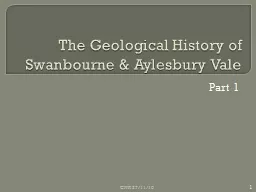

Swanbourne amp Aylesbury Vale Part 1 1 CNR 271110 Superposition shown in a soil section in Swanbourne 2 CNR 271110 Geological map of Swanbourne 3 CNR 271110 JURASSIC AND CRETACEOUS PERIODS ID: 576671
Download Presentation The PPT/PDF document "The Geological History of" is the property of its rightful owner. Permission is granted to download and print the materials on this web site for personal, non-commercial use only, and to display it on your personal computer provided you do not modify the materials and that you retain all copyright notices contained in the materials. By downloading content from our website, you accept the terms of this agreement.
Slide1
The Geological History of Swanbourne & Aylesbury Vale
Part 1
1
CNR 27/11/10Slide2
Superposition – shown in a soil section in Swanbourne
2
CNR 27/11/10Slide3
Geological map of Swanbourne
3
CNR 27/11/10Slide4
JURASSIC AND CRETACEOUS PERIODS
Sedimentation in
sub-tropical
latitudes
4
CNR 27/11/10Slide5
The world 150 million years ago in late Jurassic times showing the break up of Pangea
, the ancient supercontinent
5
CNR 27/11/10Slide6
The
North Atlantic is beginning to open along constructive plate margins to the E and W of Greenland. North America and Eurasia are separating. Shallow seas, shown in pale blue, are found above many areas of continental crust, giving widespread shallow water deposition on continental shelves.
UK
6
CNR 27/11/10Slide7
Lower Cretaceous palaeogeographic map
This map shows that most of the area that is now the UK was covered by water in the Lower Cretaceous, although different sediments were deposited in different places. In the Upper Cretaceous sea-level rose again so that Chalk was deposited everywhere.
clay
sands
7
CNR 27/11/10Slide8
Sea-levels rose during the Jurassic and Cretaceous periods. As Pangaea broke apart, constructive plate margins displaced ocean water onto continental shelves. Fluctuating sea-levels in the Jurassic and Cretaceous periods led to a great variety of deep and shallow water
continental shelf sediments.
higher
lower
8
CNR 27/11/10Slide9
Stratigraphic
table
Jurassic and Cretaceous periods
MESOZOIC ERA
PHANEROZOIC EON
9
CNR 27/11/10Slide10
10
CNR 27/11/10Slide11
The rocks exposed at the surface in Buckinghamshire range from the Quaternary glacial deposits (less than 2.6 million years old) to the Upper
Lias
(Jurassic 190 million years old) in the north of the county. However, this is only part of the story, below the surface much older rocks are present.
The figure below shows a cross section through Buckinghamshire from north to south. The different rock layers are shaded by different colours. In order to display such a long distance, the section has been squeezed and the vertical scale exaggerated. The rocks dip to the South-East by 1 to 2 degrees.
Chilterns
Whitchurch
Swanb
Ayls
11
CNR 27/11/10Slide12
Local ammonites, gastropods and bivalves
12
CNR 27/11/10Slide13
Bivalve fossils normally have two valves that are mirror images of each other.
There are exceptions to this in both modern and fossil species, where the valves
are asymmetrical.
E.g.
Gryphea
from the
Jurassic, an ancient oyster. This is the fossil you are most likely to dig up in the garden, as they are common in the Oxford Clay.
CNR 27/11/10
13
Gryphea
– the “devil’s toe nail”Slide14
Ammonite
suture shapes help to identify them
Ammonite suture lines
septum
14
CNR 27/11/10Slide15
Nautilus from the Pacific Ocean is the nearest living relative of ammonites today
15
CNR 27/11/10Slide16
Belmnites are are ancestors of the cuttlefish. They are the internal bones of these ancient squid. They look like bullets and may be found in gardens in this area. They are made of calcite.
16
CNR 27/11/10Slide17
The Portland Limestone as seen in buildings around Swanbourne
17
CNR 27/11/10Slide18
Most pieces of Portland Limestone show shell sections
18
CNR 27/11/10Slide19
Clams & oysters today and a Jurassic fossil oyster (
Gryphaea) from the clay of Charlton Close (bottom right)
19
CNR 27/11/10Slide20
Twenty million years ago, the Alpine earthy movements uplifted South East England. Within the last two million years, the climate has been cool enough to result in four major glacial advances. Only the penultimate one reached us with glaciers melting here. The result is a thin superficial deposit in many places above the bedrock of either boulder clay or outwash sands and gravels.
20
CNR 27/11/10
The Ice AgeSlide21
The Archaeology of Swanbourne
Part 2
21
CNR 27/11/10Slide22
Stone age flints show percussion marks around the edge. A single flint tool has been found from
Swanbourne
. Iron age coins have been found in Hoggeston
Hand axe
22
CNR 27/11/10Slide23
Ditch digging resulted in Ken Reading finding Roman pot remains; early 1990’s
23
CNR 27/11/10Slide24
Roman pottery fragments found by Ken Reading between Swanbourne and
Hoggeston
24
CNR 27/11/10Slide25
Roman pottery fragment - tableware with dot decoration.
25
CNR 27/11/10Slide26
Ridge and furrow fields between
Swanbourne
and
Hoggeston
26
CNR 27/11/10Slide27
Saxo-Norman to Medieval pottery fragments from Swanbourne
27
CNR 27/11/10Slide28
Late Saxon pottery
28
CNR 27/11/10Slide29
Medieval pottery
29
CNR 27/11/10Slide30
Blue Willow Pottery
Blue Willow pottery was
in common
useage
in the 1700s. It
was f
irst
manufactured at
Caughley
Pottery Works
by Thomas Turner.
Blue Willow pieces quickly grew to become popular dishes for use in the home
. Fragments are common in gardens around
Swanbourne
.
30
CNR 27/11/10Slide31
Comparision
of early willow leaf with brush strokes (left) with later willow leaf with transfer background dots (right).
31
CNR 27/11/10Slide32
What you might expect to dig up – examples from Station Road
32
CNR 27/11/10Slide33
Clay pipe fragments date from the 17
th
to the 19th century (from Charlton Close)
33
CNR 27/11/10Slide34
Metal objects – Station Road
34
CNR 27/11/10Slide35
Great Western Railway employee’s brass button
35
CNR 27/11/10Slide36
The End
36
CNR 27/11/10